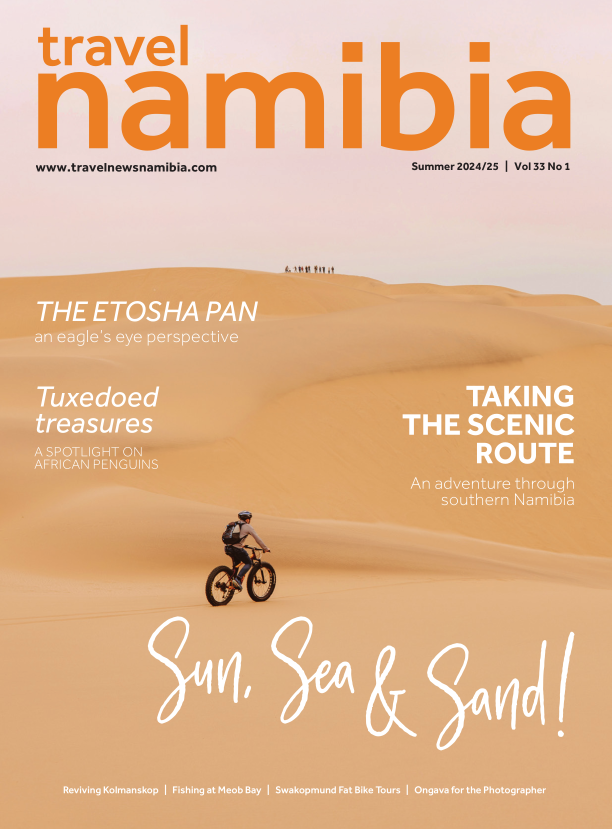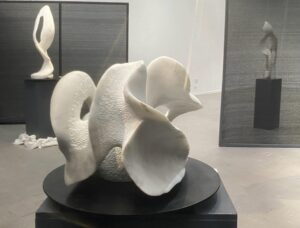
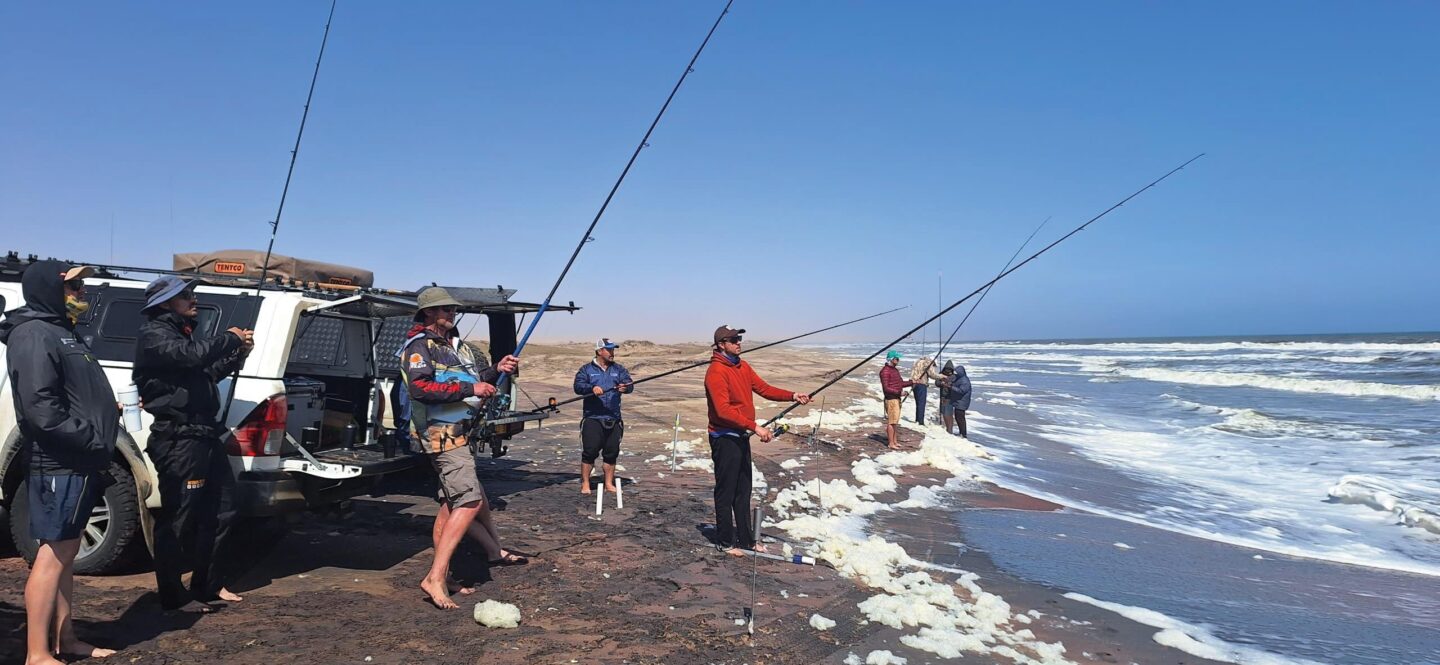
Friends gone fishin'
On a fishing expedition to Meob Bay along Namibia’s southern coastline, Theuns Laubscher and a group of friends discovered the wonders of the vast Namib Sand Sea, a UNESCO Natural World Heritage site. Led by concession guides through the ancient sands and along the skeleton-strewn coast, the group discovered the delicate balance of catch-and-release angling, the thrill of off-road convoys, and the unfiltered camaraderie forged around campfires under an endless sky. This story is not just about fishing; it is about adventure, resilience and the quiet marvels of the Namib, and that magical place where the desert meets the sea.
Photographs Francois Pretorius & Stefan du Raan
From the Summer 2024/25 issue
There is only one word that captures the feeling leading up to a trip like this: excitement.
The build-up is exhilarating, from joining the WhatsApp group – where jokes and plans are shared as the group gradually grows – to gathering all the essentials.
Then comes the packing. At first, I thought that my three companions and I could fit all our stuff into the Fortuner. I mean, it’s just a sleeping bag and a pillow… and our fishing gear… and the beverages… and ice… and, well, extra fuel, because Puma has not yet set up shop in the middle of the Namib. Then, the camp leader informed me that everyone had to collect an ammo box full of food from him, which I planned for. But with the ammo box came 20 kilograms of potatoes and 20 litres of cooking oil – not planned for. Slowly, as everything on the packing list gathered in the garage, I realised three more heaps like this wouldn’t fit into the Fortuner, and we’d have to split up the group.
So I ended up fitting in just one friend, and to make that work, I removed the backseats. In their place went a camping fridge for refreshments within arm’s reach, a cooler just for the ice and a 40-litre water tank. In the back, we packed the bedding, snacks, a small travel bag, fishing equipment and 55 litres of fuel. From Walvis Bay to Meob Bay is about 250 kilometres, and then you turn around and head back again. However, driving through thick beach sand and the warm Namib dunes can bring the fuel economy of a 9 km/l vehicle down to around 5 km/l (if you drive a new Ford Raptor or an old Toyota 4.5 EFI Cruiser, you better plan for about 1 km/l).
On the first morning, we met at a fuel station in southern Walvis Bay about an hour before sunrise to fill up the vehicles and coffee cups. As always, there were those who felt that garage coffee wasn’t good enough and went to Slowtown, bought the good coffee only for themselves, and then arrived at the meeting point 30 minutes after we were supposed to leave, still needing to fuel up. (These types usually drive Cruisers with spacers and cannot follow the first rule, which I’ll get to in a moment.)
Finally, we headed out of town, each vehicle equipped with a two-way radio, over which we shared pre-planned call signs (including a reluctant new one for the coffee-Cruiser). We stopped at the southern end of the saltworks on the way to Pelican Point, where the rules were explained and the tyres deflated to a measly 0.8 bar. If you want to struggle through the sand, you stop deflating before you reach 0.8. Those who thought they knew better soon learnt the importance of this advice from the guides. I cannot remember all the rules, but rule number one stuck with me: STAY IN THE TRACKS. We aim to leave as few tracks as possible, creating a single “tweespoorpaadjie” all the way, like a centipede, no diverging. I think rule number two was something like DON’T BE DIFFICULT, BE LEKKER – I might be paraphrasing.
The radio buzzed with chatter, jokes and introductions as we drove. Our guide, PW – the concession holder – shared insights about the journey as we went along. Bringing up the rear of the convoy was a man introduced as “Muis”, the man responsible for keeping everyone in line. He proudly wears a sarong because it suits his style.
We passed Sandwich Harbour at low tide, hence the need to leave at sunrise, and then we headed into the dunes. This was when the drivers began to truly understand their vehicles, as for most, it was their first time in the mighty dunes of the Namib. PW coached us with encouragements like “gooi mielies” and “gee gas” when more horsepower was needed, and a calming “stadig” when it was time to ease off a little. One driver in a Hilux didn’t give enough “mielies”, and although stopping halfway up the dune was not a problem, he nearly turned too sharply on the descent, risking a rollover. Thankfully, he saved it, but it was a timely reminder that anything can happen out here.
We emerged from the dunes onto the beach, right in front of one of the desert’s gems: the Shawnee shipwreck, an insurance scam gone wrong in 1976. We stopped here briefly to stretch our legs and snap some photos, preparing for a fast, long drive along the beach. This was where the coffee-Cruiser with its spacers proved incapable – or unwilling – to stay in the tracks, weaving left and right, and sometimes veering completely off course. But, not to worry, at the next stop they received their “discipline” in the form of a short sip from a big, ice-cold, rectangular green bottle. It didn’t help that everyone else seemed excited about the prospect of receiving the same form of “discipline”, but at least the message was clear.
Our next stop was unforgettable: a massive 310-foot, 2,200- ton ship stranded in the desert some 400 metres away from the coastline – the Eduard Bohlen wreck. It’s incredible to see a behemoth like that swallowed by sand – a testament to the constant shifting of the Namib’s dunes. Just imagine how the coastline must have changed over the decades to allow for such a phenomenon.
Another long stretch down the beach, and the new Raptor was finally finding its footing – and the driver, the gas pedal. Halfway through, we had the first fuel stop for the thirsty Raptor. When men travel together, they inevitably talk about their own and each other’s vehicles. It’s part of the fun – the horsepowers, the torques, the fuel economy… That’s when I realised my pockets aren’t deep enough to keep a beauty like that running, so I’ll happily stick to my D4D Fortuner.
We slowed down at Meob Bay, where a restored wooden hut still stands – the transport manager’s hut. Nearby, two surfboats lay as relics. It is heartening to see the effort put into preserving a deserted area like this, keeping alive the rich heritage of this beautiful country. This place marks the early days of industries like whaling and diamond mining, the start of Namibia’s growth that, over time, built the infrastructure we love and depend on today.
Just south of Meob lies the “whale cemetery”, where thousands of bones are strewn across the barren landscape. If you don’t stop to look closely, you might mistake them for pieces of driftwood, baked white and dry by the sun, salt and wind.
A little further south, we arrived at NAMAB Camp, and we couldn’t believe our eyes. Ten brand-new wooden chalets on stilts, each with warm water and electricity, comfortable enough to bring the whole family along. PW and his team drove every single shingle and nail here, hauling it all one trailer load at a time across the same stretch of desolate desert we had just travelled. Yes, with a trailer, through the same sand where most of us normies get stuck because we don’t know any better.
We unloaded everything and prepared for the main event: fishing. The rules were simple. All fish were catch-and- release, and you don’t touch the fish. The hooked fish – mostly steenbras – were guided in shallow water into a canvas hammock, where we had a split second for a photo before releasing it. This method preserves the protective slime layer on the fish’s scales, which guards against bacterial infection. Breaking that layer by handling can quickly lead to infections that might kill the fish. Some fish of the correct size were kept by the catering team for supper, but no fish were allowed out of the park.
The fresh fish kept us well-fed and fuelled for our time there. On the first day, the cooks prepared the steenbras as deep- fried crumbed fish nuggets. We couldn’t get enough. That first evening, there weren’t enough nuggets to go around, so on the second evening, they made twice as many, and it still wasn’t enough. Thankfully, there was also fish and chips to satisfy the cravings for fresh fish. Hopefully, some of those potatoes that hitched a ride with me found their way into the mix so I wouldn’t have to haul them back.
We ate like kings. On the third and fourth evenings, heaps of delicious steenbras and kabeljou sashimi were set out as hors d’oeuvres. Yet we still clamoured for those fish nuggets. Muis prepared an unrivalled lamb spit, and as we gathered around the fire under an unadulterated sky, the nights stretched on into the darkness – timeless and vast.
Breakfast was a simple but satisfying spread of coffee, rusks, yoghurt, fresh fruit, eggs and bacon. Lunch on the beach where we fished included a magnificent cheese platter one day and a lamb and pork braai the next.
The fishing expeditions were outstanding. PW would stop at a spot, and within five minutes, the first fish was hooked, with many more to follow. If one area ran dry, we would move a bit north or south, and soon the reels were spinning again. It felt like the stories of old when fish were plentiful on Namibia’s west coast.
When the last day came, we packed up and started the convoy back, PW leading and Muis making sure the coffee-Cruiser behaved at the rear. We all stopped together one last time in Walvis Bay, gathered as a group for the final time until next year. New faces will join, some familiar ones might not return. Who will it be? What new stories will unfold around the fire? And will there be enough fish nuggets?
The world out there is still wild and untouched. The jackals don’t know they’re supposed to fear humans. It’s an experience like no other. Free from cellphone reception, we get a chance to reconnect – whether with those around us or with ourselves. In these sands, you might just lose yourself, but in doing so, you might also find yourself again. TN
More to explore


Discover Airlines launches a new direct flight between Windhoek and Munich
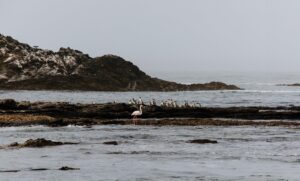
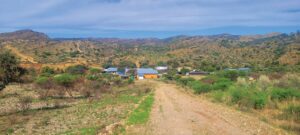


Discover Airlines launches a new direct flight between Windhoek and Munich





